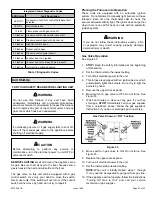
507324-01B
Page 26 of 32
Issue 1809
Turning Off Gas to Unit
1. Set the thermostat to the lowest setting.
2. Turn OFF all electrical power to the unit if service is to
be performed.
3. Remove the upper access panel.
4. Move switch on gas valve to OFF. Do not force.
5. Replace the upper access panel.
Failure to Operate
If the unit fails to operate, check the following:
1. Is the thermostat calling for heat?
2. Are access panels securely in place?
3. Is the main disconnect switch closed?
4. Is there a blown fuse or tripped circuit breaker?
5. Is the filter dirty or plugged? Dirty or plugged filters will
cause the limit control to shut the unit off.
6. Is gas turned on at the meter?
7. Is the manual main shut-off valve open?
8. Is the internal manual shut-off valve open?
9. Is the unit ignition system in lock out? If the unit locks
out again, call the service technician to inspect the unit
for blockages.
10. Is pressure switch closed? Obstructed flue will cause
unit to shut off at pressure switch. Check flue and
outlet for blockages.
11. Are flame rollout switches tripped? If flame rollout
switches are tripped, call the service technician for
inspection.
Heating Sequence of Operation
1. When thermostat calls for heat, combustion air blower
starts.
2. Combustion air pressure switch proves blower
operation. Switch is factory set and requires no
adjustment.
3. After a 15 second pre-purge, the hot surface ignitor
energizes.
4. After a 20 second ignitor warm-up period, the gas
valve solenoid opens. A 4 second trial for ignition
period begins.
5. Gas is ignited, flame sensor proves the flame, and the
combustion process continues.
6. If flame is not detected after first ignition trial, the
ignition control will repeat steps 3 and 4 four more
times before locking out the gas valve. The ignition
control will then automatically repeat steps 1 through
6 after 60 minutes.
7. To interrupt the 60 minute, move thermostat from
“Heat” to “OFF” then back to “Heat”. Heating sequence
then restarts at step 1.
Gas Pressure Adjustment
Gas Flow (Approximate)
Gas Meter Clocking Chart
Unit
Seconds for One Revolution
Natural
LP
1 cu ft
Dial
2 cu ft
Dial
1 cu ft
Dial
2 cu ft
Dial
-045
80
160
200
400
-070
55
110
136
272
-090
41
82
102
204
-110
33
66
82
164
Natural - 1000 btu/cu ft
LP - 2500 btu/cu ft
Table 8.
Manifold Pressure and Line Pressure at Various Altitudes
Capacity
Manifold Pressure (in. w.c.)
1
Line Pressure (in. w.c.)
0 - 2000 ft.
2001 - 4500 ft.
4501 - 7500 ft.
7501 - 10000 ft.
Minimum
Max.
Nat.
Gas
LP
Gas
2
Nat.
Gas
LP
Gas
2
Nat.
Gas
LP
Gas
2
Nat.
Gas
3
LP
Gas
2
Nat.
Gas
LP
Gas
2
Nat. &
LP
045
3.5
10.0
3.2
10.0
3.0
10.0
3.5
10.0
4.5
11.0
13.0
070
3.2
10.0
2.8
10.0
090
3.2
10.0
2.7
9.6
110
3.5
10.0
3.0
9.6
1
Manifold pressure adjustments based on 1020 Btu/ft
3
gas for natural and 2500 Btu/ft3 gas for LP (corrected to standard conditions).
Consult local utility for actual local heating value.
2
A natural to LP/Propane gas conversion Orifice Kit is required to convert this unit. Refer to kit instructions for conversion procedure.
3
A high altitude natural Orifice Kit is required.
Table 9.







































